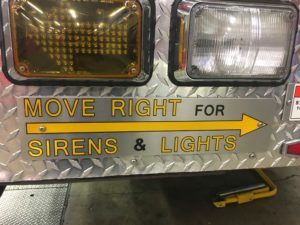
 SEATTLE: With the viaduct closure quickly approaching, the Seattle Fire Department wants to remind drivers to move right for lights and sirens. Seattle Fire, Police and Department of Transportation personnel respond to traffic incidents in the city 24/7. Many times, private vehicles do not yield the right of way when approached by emergency vehicles with lights and sirens.
SEATTLE: With the viaduct closure quickly approaching, the Seattle Fire Department wants to remind drivers to move right for lights and sirens. Seattle Fire, Police and Department of Transportation personnel respond to traffic incidents in the city 24/7. Many times, private vehicles do not yield the right of way when approached by emergency vehicles with lights and sirens.
“With the added traffic from the viaduct closure, we want to put an extra emphasis on encouraging drivers to move right for lights and sirens,” said Seattle Fire Chief Harold Scoggins, “when drivers are attentive to emergency vehicles, it helps keep members of the public and our responders safe.”
When you see emergency vehicles traveling with lights and sirens:
The Revised Code of Washington (RCW) 46.61.210 requires that “…the driver of every other vehicle shall yield the right of way and shall immediately drive to a position parallel to, and as close as possible to, the right-hand edge or curb of the roadway clear of any intersection and shall stop and remain in such position until the authorized emergency vehicle has passed, except when otherwise directed by a police officer.”
This law also requires pedestrians to yield to emergency vehicles when they are responding to an incident.
Here are a few recommended tips for keeping you and our responders safe:
- If your vehicle is in motion, move to the right as soon as it is safe to do so and come to a full stop.
- If you are unable to move to the right, slow and come to a full stop.
- If you are stopped, stay stopped unless directed otherwise.
- Do not move to the left unless directed to do so.
- Remember that the law applies to emergency vehicles approaching from any direction, not just from behind.
- Do not attempt to follow an emergency vehicle too closely. You are required to stay 500 feet back.
- If you are standing at the curb or on a sidewalk, do not cross the street until the emergency vehicle has passed.
Emergency responders are taught to pass on the left side. This may mean that they are forced to move into on-coming traffic lanes, but lights and sirens make them highly visible to everyone, reducing the risk.
Approaching parked emergency vehicles with lights and sirens:
Once emergency vehicles arrive at an incident, such as a vehicle collision, they will park and continue to utilize their lights. RCW 46.61.212 requires drivers to approach an emergency scene with caution and, if reasonable, yield the right of way by changing lanes to the left.
References: Puget Sound Regional Fire Authority